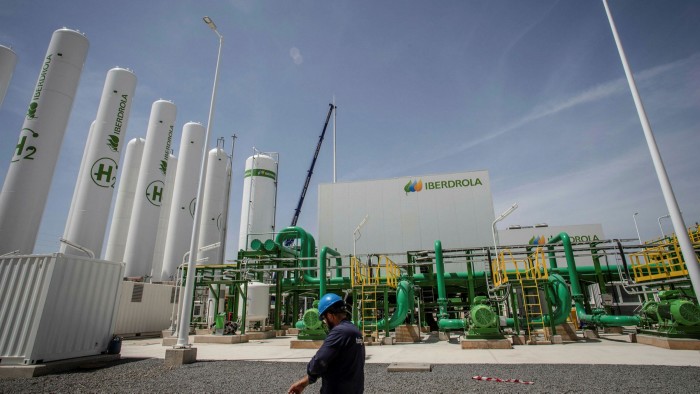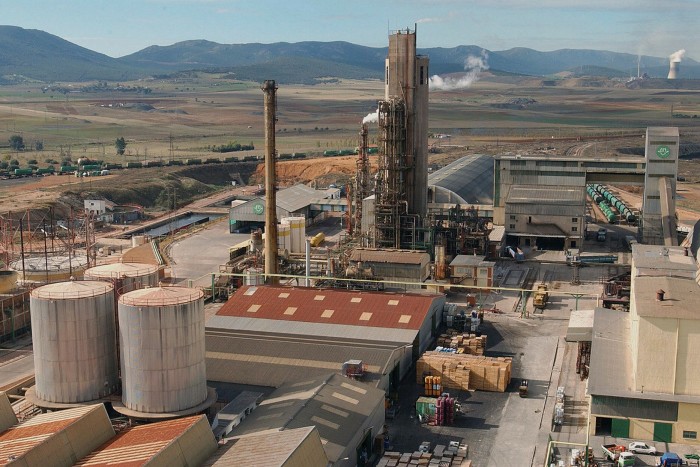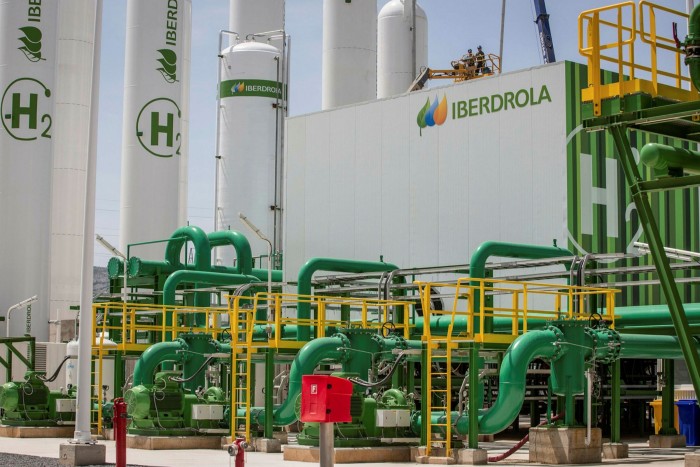Spain bets green hydrogen will be more than a bubble

Simply sign up to the Renewable energy myFT Digest -- delivered directly to your inbox.
A new green hydrogen plant in Puertollano, in the southern part of central Spain, shows both the grand ambitions — and the obstacles — the country faces in its quest to become a European hub for this vehicle fuel of the future.
After a €150mn investment, Puertollano has the capacity to be a major provider of green hydrogen for industrial use in Europe, as part of a plan to achieve 800-megawatt capacity by 2027. Green hydrogen is a zero-carbon fuel created using renewable energy rather than fossil fuels, and the new plant eventually will be able to produce 3,000 tonnes of it.
But, because it has yet to receive EU certification and subsidies as an Important Project of Common European Interest (a term for strategic investments), it is not yet “economically viable” and so not operating, explains Millán García-Tola, hydrogen director at Iberdrola, the Spanish energy group that built the plant.
Spain has the ideal conditions, though, to become Europe’s green hydrogen hub, according not only to industry analysts, but also to Pedro Sánchez, the country’s prime minister. He cites high levels of public and private sector investment in facilities under the country’s €70 billion Covid recovery plan, while energy experts note strong supplies of renewable energy and existing gas infrastructure.
Spain, as a hub, could therefore provide the whole continent with a cleaner energy mix and help free it from its dependence on Russian gas.
And some companies are starting to think Sanchez may be right.
Among them is US automotive and heavy equipment maker Cummins. The Indiana-based multinational develops alternative fuel engines and, in collaboration with Iberdrola, has announced a €50mn plant in Spain to make electrolyser systems to produce green hydrogen.
But will green hydrogen exports — and hydrogen-powered vehicles and ships — play a significant role in Spain’s future at any time soon?

Electrolysers use electricity to break water down into hydrogen and oxygen, and Spain has the advantage of a large renewable energy sector that provided almost 47 per cent of its electricity in 2021.
“Spain has many of the characteristics of the countries that can be champion green hydrogen exporters,” says Gonzalo Escribano, head of the energy and climate program at the Elcano Royal Institute, a think-tank in Madrid. As well as the plentiful and cheap renewable energy, he points to the country’s ample network of liquefied natural gas (LNG) terminals and pipelines, and an existing industrial base that works with the gas industry.
These advantages have led Spain’s government to make a big bet on the country becoming a leading producer of cheap green hydrogen — both to sell and to make available to industry — as well as a provider of machinery to produce the fuel.
Spain’s plan — with financing from the EU coronavirus recovery fund — includes €1.55bn for green hydrogen over the next three years. In May, at a presentation for the Cummins-Iberdrola plant, Sánchez declared Spain was “in the best position to be not just another hub, but the green hydrogen industrial hub in Europe”.
The prime minister’s enthusiasm is echoed by the local industry. Maarten Wetselaar, chief executive of Spanish oil and gas multinational Cepsa — which plans green hydrogen plants with a capacity of 2 gigawatts — sees Spain acting as a hub for the fuel, just as Rotterdam does for oil.
Similarly, Arturo Gonzalo Aizpiri, head of Spanish energy company Enagás, notes that a “hydrogen ready” gas pipeline to France, which is on the drawing board, could transport 10 per cent of the EU’s annual hydrogen consumption by 2030.

Several obstacles stand in the way of progress, however.
Price is the largest of these. The Spanish government estimates that domestic industries, such as chemicals and fertilisers, consume 500,000 tonnes of hydrogen a year. This “grey” hydrogen, which is extracted from natural gas, costs as little as €1-€1.50 per kilo. Green hydrogen from water, by comparison, costs an uncompetitive €5-€7 per kilo.
“We need to make more efficient electrolysers to lower the cost of a kilo of hydrogen by 50 per cent, to make it fully competitive with gas,” says Aizpiri, who sees hydrogen production expanding by an “extraordinary amount” in the middle of the decade, after a slow start. Enagás opened a green hydrogen plant on the island of Mallorca in March.
A second key challenge is transporting hydrogen around Spain and abroad. It is lighter and more corrosive than natural gas, so current pipelines could only handle a mix of 10-12 per cent hydrogen with natural gas. Hydrogen can also be liquefied and shipped like natural gas, but it needs to be chilled to -260C, which is 100 degrees below regular LNG.
“In the medium to long term, you will have liquid hydrogen ships going around the world,” predicts one energy industry chief. He adds, however, that it will take 40 years to transform the whole energy system.
A prominent view is that, in the near term, Spain should moderate its hydrogen goals. “We’re living in a bubble of green hydrogen,” says García-Tola. “We’re looking for uses that don’t make sense.”
He sees some applications in transport, although these appear quite limited. For example, there are currently eight green hydrogen-powered buses that Iberdrola fuels in the city of Barcelona.
Fertiliser production is a more obvious opportunity, and Garcia-Tiola suggests green hydrogen could replace natural gas in industries that require extreme heat and therefore cannot be electrified — such as steel, ceramics, and cement. But making hydrogen competitive, meanwhile, will require government subsidies or carbon pricing on dirty fuels, he believes.
In short, fulfilling Spain’s green hydrogen dream will take longer than optimists may hope.
“The issue with hydrogen is that it’s long term,” asserts Escribano. “We can’t replace Russian gas in a year or two.”
Climate Capital

Where climate change meets business, markets and politics. Explore the FT’s coverage here.
Are you curious about the FT’s environmental sustainability commitments? Find out more about our science-based targets here

Comments